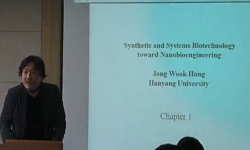Eighty-five different cultivars of Brassica rapa, B. juncea, B. nap us, B. carinata, B. oleracea and hexaploid Brassica collected from Bangladesh, Japan, China and Denmark were analyzed by SDS-PAGE for seed and leaf protein variations, using esterase,...
http://chineseinput.net/에서 pinyin(병음)방식으로 중국어를 변환할 수 있습니다.
변환된 중국어를 복사하여 사용하시면 됩니다.
- 中文 을 입력하시려면 zhongwen을 입력하시고 space를누르시면됩니다.
- 北京 을 입력하시려면 beijing을 입력하시고 space를 누르시면 됩니다.
Identification of Different Species and Dultivars of Brassica by SDS-PAGE, Isozyme and Molecular Marker
한글로보기https://www.riss.kr/link?id=A105665434
- 저자
- 발행기관
- 학술지명
- 권호사항
-
발행연도
2005
-
작성언어
English
- 주제어
-
자료형태
학술저널
-
수록면
27-35(9쪽)
- 제공처
-
0
상세조회 -
0
다운로드
부가정보
다국어 초록 (Multilingual Abstract)
Eighty-five different cultivars of Brassica rapa, B. juncea, B. nap us, B. carinata, B. oleracea and hexaploid Brassica collected from Bangladesh, Japan, China and Denmark were analyzed by SDS-PAGE for seed and leaf protein variations, using esterase, acid phosphatase and peroxidase isozyme analysis. Ten polymorphic bands were identified from seed protein however no identifiable polymorphic band was found in the leaf protein. Polymorphic markers clearly distinguished the different Brassica species as well as yellow sarson (YS) and brown seeded (BS) cultivars of B. rapa. The $F_1$ cross between YS and brown seeded cultivars showed the existance of all poly-morphic bands of the respective parents. The Bangla-deshi and Japanese cultivars of B. rapa differed in the amount of seed protein. In the case of isozyme analysis, esterase showed the highest number of polymorphic bands (13) followed by acid phosphatase (9) and peroxidase (5). These polymorphic markers were very effec-tive for classification of all the species studied in this experiment. In parentage tests using isozymes, the hybridity of intra-and-interspecific crosses of almost all the seedlings could be identified from their respective cross combinations. Esterase polymorphism showed a clear differentiation between YS and BS types of B. rapa. In addition, two esterase polymorphic markers were iden ified to differentiate some cultivars of B. juncea. Segregation patterns in these two esterase bands showed a simple Mendelian monohybrid ratio of 3:1 in $F_2$, 1:1 in test cross and 1:0 in back cross progenies. No polymorphic band was identified to distinguish different cultivars of the same species by acid phosphatase or peroxidase. Polymerase Chain Reaction (PCR) was carried out with seed coat color specific marker of B. juncea. The yellow seeded cultivars produced a strong band at 0.5 kb and weak band 1.2 kb. In the addition of these two specific bands, Japanese yellow-seeded cultivars expressed two more weak bands at 1.0 kb and 1.1 kb. Where the brown seeded cultivars generated a single strong band at 1.1 kb. In segregating population, the yellow seed coat color marker segregated at a ratio 15 (brown) : 1 (yellow), indicating the digenic inheritance pattern of the trait.
동일학술지(권/호) 다른 논문
-
Effect of Nutrient Media and Sucrose Concentration on Shoot Organogenesis in Tomato
- The Korean Society of Plant Biotechnology
- Bhatia Poonam
- 2005
-
- The Korean Society of Plant Biotechnology
- Franklin G.
- 2005
-
- The Korean Society of Plant Biotechnology
- Lee Gunho
- 2005
-
Salt Tolerance in Plants - Transgenic Approaches
- The Korean Society of Plant Biotechnology
- Sangam S.
- 2005




 ScienceON
ScienceON





